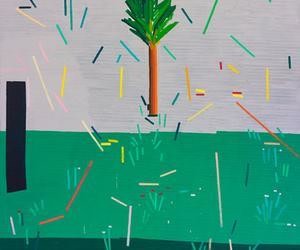Guy Yanai at Ameringer | McEnery | Yohe
Artsy, Contemporary Concerns, Prehistoric Medium: A Conversation with Israeli Painter Guy Yanai
16 July 2015

Hours before he was to board a plane home to Tel Aviv, I sat with Guy Yanai in the middle of Ameringer | McEnery | Yohe in Chelsea, encircled by a selection of his light-infused paintings. Each of the pieces consists of stacked, horizontal stripes of pigment, as if their scenes were viewed from behind a subtle scrim of blinds. Although he’d been in New York for less than a week, for the successful opening of “Ancienne Rive,” the solo show of new paintings that surrounded us, Yanai told me he was ready to return to his studio and to painting—to the work that most fulfills him.
In fact, it seems as if choice has never figured into Yanai’s career. He always knew he wanted to be an artist, a desire that solidified at a young age. “When I was 15, I read this book by Toni Morrison. And it was so inspiring that I made this kind of teenager painting all night,” he recounted. “And that’s when I realized this is really what I wanted to do, forever.” From that point forward, Yanai pursued painting with a sustained focus, achieving what he describes as “early success” in his late teens and early 20s. “And then you get out of school and real life comes in,” he said. “I had to work as a graphic designer and do all these jobs, and it was really hard. I felt like I kind of failed. I had five difficult years, but those years now are so important for me—to be on the floor and then to climb back up.”
Since 2006, Yanai has been able to make art on a full-time basis, feeding a passion for painting that is so intuitive it seems almost unreasonable to ask him to put it into words. “I don’t think I chose painting. I think painting chose me,” he said. “When I start mixing paint and painting, I’m assuming it’s what it feels like for a heroin addict, to do something that feels so good.” But with this high comes a reality check, which Yanai is quick to point out. In the digital age, painting may be seen as an anachronism. And he prefers to work with only its most fundamental elements: pigments, brushes, and linen canvases.
Yanai may be working with an ancient medium, but he’s a decidedly 21st-century artist. Through the style and subject matter of his work, he aims to make his paintings as contemporary as possible. As he put it, painting is “a primitive thing. And then I want to flip it and make it something of the highest sophistication…. I want to grab those two poles at the same time—the highest sophistication and a real, primal kind of thing.”
His process begins with images. In addition to tapping into the archive of iPhone photos he’s built up over the years, Yanai calls them up from memory, borrows them from the work of artists he admires, and culls them from the web and social-media sites like Tumblr, among other sources. Everything is fair game. “The main job, after looking at and hoarding these images, is to edit them and to see what will be able to carry a painting,” he explained. He always works on multiple canvases at once, isolating single images on some, combining a fragmentary assortment of disparate ones on others.
In “Ancienne Rive,” lakes, seas, swimming pools, and sprinklers intermingle with strips of land and sky, potted plants, and houses. Intimately scaled paintings dot the gallery walls, centered upon a single element—a pink box on a gray ground, the triangular tip of a roof, a sailboat on Lake Kinneret—and larger compositions read as tightly framed landscapes. All are rendered in bright, Levantine hues of pink, green, blue, gray, orange, and yellow, but these sun-soaked visions stem from darker concerns. Among them is Yanai’s fascination with edges and borders (“Rive” refers to the place where water meets land), and his keen awareness of the contentiousness of his own country’s borders—or, as he said, “I come from a country that really has no borders.”
Both actual and implied, borders structure these paintings—from the thin spaces between strips of color, to the separation between areas of water, land, and sky, to the places where walls of houses meet their outdoor surroundings. There are the edges of his canvases and what lies outside of them, his vignettes suggesting much larger spaces and terrains beyond the frame. While the disputes over Israel’s borders and their ramifications seep into who Yanai is as a person and an artist, he does not want to define his work solely by this conflict.
I’m more into confronting myself than confronting the political situation of my country and her neighbors,” he said. “For me, art is about self-confrontation.” Perhaps more than anything else, he confronts within himself an unshakable sense of rootlessness, born from an upbringing marked by frequent moves with his family. “I’ve learned to embrace it,” he said. “I don’t go against it, I don’t struggle with it, I want to feel it out ... I want to be able to hold it.” And though this condition causes him pain, it makes for great art.
Karen Kedmey
Guy Yanai, Ancienne Rive” is on view at Ameringer | McEnery | Yohe, New York, Jul. 9 – Aug. 14, 2015.
Image (detail): Guy Yanai, Ancienne Rive (A Tree and a Cave), 2015, Oil on linen, 72 x 60 inches, 182.9 x 152.4 cm, A/Y#22575